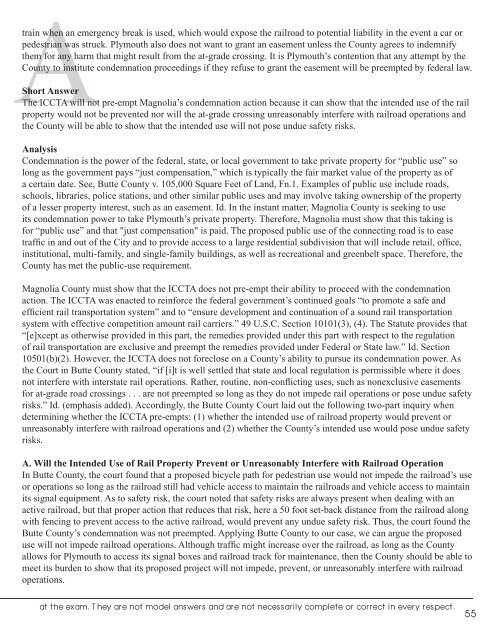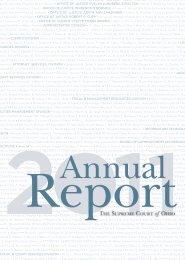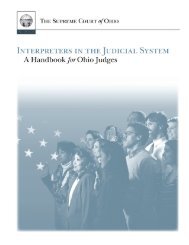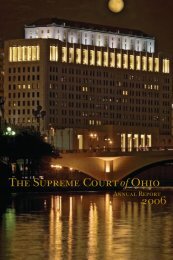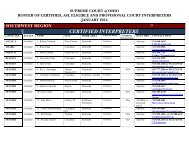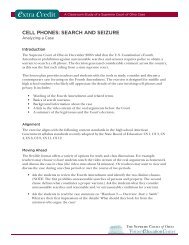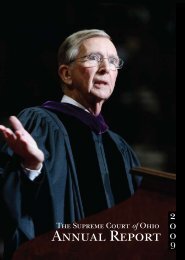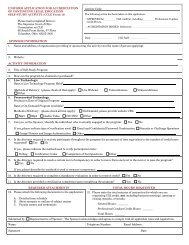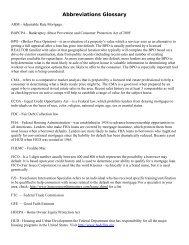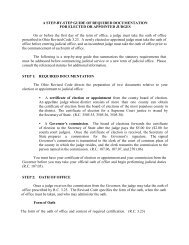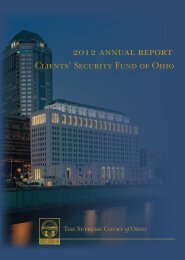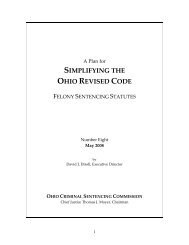The Supreme Court of Ohio February 2011 Ohio Bar Examination
The Supreme Court of Ohio February 2011 Ohio Bar Examination
The Supreme Court of Ohio February 2011 Ohio Bar Examination
You also want an ePaper? Increase the reach of your titles
YUMPU automatically turns print PDFs into web optimized ePapers that Google loves.
Atrain when an emergency break is used, which would expose the railroad to potential liability in the event a car or<br />
pedestrian was struck. Plymouth also does not want to grant an easement unless the County agrees to indemnify<br />
them for any harm that might result from the at-grade crossing. It is Plymouth’s contention that any attempt by the<br />
County to institute condemnation proceedings if they refuse to grant the easement will be preempted by federal law.<br />
Short Answer<br />
<strong>The</strong> ICCTA will not pre-empt Magnolia’s condemnation action because it can show that the intended use <strong>of</strong> the rail<br />
property would not be prevented nor will the at-grade crossing unreasonably interfere with railroad operations and<br />
the County will be able to show that the intended use will not pose undue safety risks.<br />
Analysis<br />
Condemnation is the power <strong>of</strong> the federal, state, or local government to take private property for “public use” so<br />
long as the government pays “just compensation,” which is typically the fair market value <strong>of</strong> the property as <strong>of</strong><br />
a certain date. See, Butte County v. 105,000 Square Feet <strong>of</strong> Land, Fn.1. Examples <strong>of</strong> public use include roads,<br />
schools, libraries, police stations, and other similar public uses and may involve taking ownership <strong>of</strong> the property<br />
<strong>of</strong> a lesser property interest, such as an easement. Id. In the instant matter, Magnolia County is seeking to use<br />
its condemnation power to take Plymouth’s private property. <strong>The</strong>refore, Magnolia must show that this taking is<br />
for “public use” and that "just compensation" is paid. <strong>The</strong> proposed public use <strong>of</strong> the connecting road is to ease<br />
traffic in and out <strong>of</strong> the City and to provide access to a large residential subdivision that will include retail, <strong>of</strong>fice,<br />
institutional, multi-family, and single-family buildings, as well as recreational and greenbelt space. <strong>The</strong>refore, the<br />
County has met the public-use requirement.<br />
Magnolia County must show that the ICCTA does not pre-empt their ability to proceed with the condemnation<br />
action. <strong>The</strong> ICCTA was enacted to reinforce the federal government’s continued goals “to promote a safe and<br />
efficient rail transportation system” and to “ensure development and continuation <strong>of</strong> a sound rail transportation<br />
system with effective competition amount rail carriers.” 49 U.S.C. Section 10101(3), (4). <strong>The</strong> Statute provides that<br />
“[e]xcept as otherwise provided in this part, the remedies provided under this part with respect to the regulation<br />
<strong>of</strong> rail transportation are exclusive and preempt the remedies provided under Federal or State law.” Id. Section<br />
10501(b)(2). However, the ICCTA does not foreclose on a County’s ability to pursue its condemnation power. As<br />
the <strong>Court</strong> in Butte County stated, “if [i]t is well settled that state and local regulation is permissible where it does<br />
not interfere with interstate rail operations. Rather, routine, non-conflicting uses, such as nonexclusive easements<br />
for at-grade road crossings . . . are not preempted so long as they do not impede rail operations or pose undue safety<br />
risks.” Id. (emphasis added). Accordingly, the Butte County <strong>Court</strong> laid out the following two-part inquiry when<br />
determining whether the ICCTA pre-empts: (1) whether the intended use <strong>of</strong> railroad property would prevent or<br />
unreasonably interfere with railroad operations and (2) whether the County’s intended use would pose undue safety<br />
risks.<br />
A. Will the Intended Use <strong>of</strong> Rail Property Prevent or Unreasonably Interfere with Railroad Operation<br />
In Butte County, the court found that a proposed bicycle path for pedestrian use would not impede the railroad’s use<br />
or operations so long as the railroad still had vehicle access to maintain the railroads and vehicle access to maintain<br />
its signal equipment. As to safety risk, the court noted that safety risks are always present when dealing with an<br />
active railroad, but that proper action that reduces that risk, here a 50 foot set-back distance from the railroad along<br />
with fencing to prevent access to the active railroad, would prevent any undue safety risk. Thus, the court found the<br />
Butte County’s condemnation was not preempted. Applying Butte County to our case, we can argue the proposed<br />
use will not impede railroad operations. Although traffic might increase over the railroad, as long as the County<br />
allows for Plymouth to access its signal boxes and railroad track for maintenance, then the County should be able to<br />
meet its burden to show that its proposed project will not impede, prevent, or unreasonably interfere with railroad<br />
operations.<br />
at the exam. <strong>The</strong>y are not model answers and are not necessarily complete or correct in every respect.<br />
55


